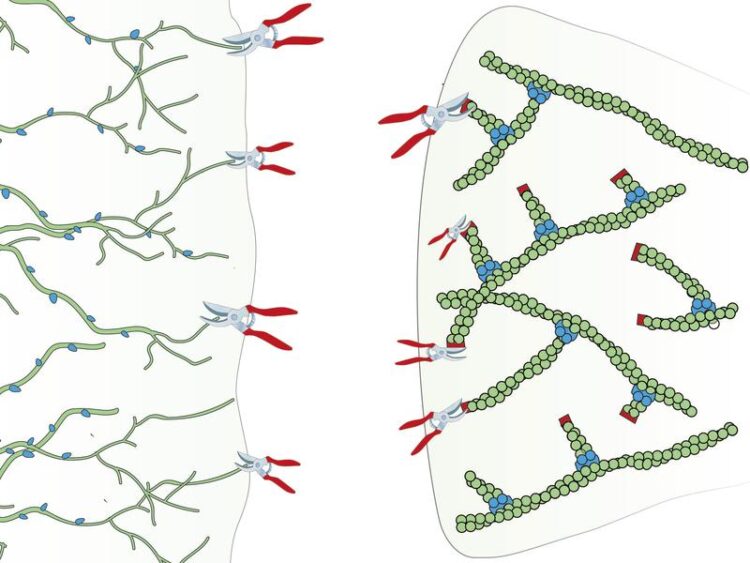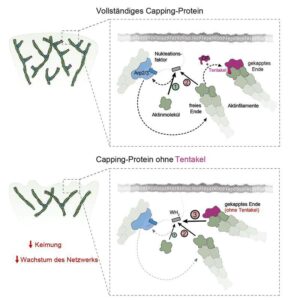How pruning the cytoskeleton moves the cell

Much like proper hedge pruning (left), capping (red) of old actin filaments (green) by the capping protein leads to the production (budding, blue) of new, branched actin filaments (right).
MPI of Molecular Physiology
Cells are characterized to be stable yet highly flexible. They constantly modify their shape and even move through tissue. These vital properties are based on a dynamically organized network of branched actin filaments, which generates pushing forces to move the cell membrane. An interdisciplinary team lead by Peter Bieling and Stefan Raunser from the Max Planck Institute of Molecular Physiology (MPI) in Dortmund has now revealed a previously unknown mechanism, explaining how stopping the growth of older actin filaments within the network promotes the formation of new ones, thereby maintaining the structure and function of the cytoskeleton, much like proper pruning of hedges in the garden.
Cells grow, divide, change their shape and move. They provide structure for the body and tissues, enter wounds to close them or chase down bacteria in our blood. The mobility of cells is a prerequisite for a variety of essential biological functions and is ensured by the cytoskeleton. This dynamic protein network assembles on the inside of the cell membrane and is responsible for the cell’s shape, its mechanical stability and it’s ability to move.
How tiny molecules assemble into large powerful structures
One key component of the cytoskeleton is actin, which can self-assemble into filaments. But where does the pushing force of the cytoskeleton actually originate from? The origin lies in a nucleation process that occurs just beneath the cell membrane. Nucleation of new actin filaments is initiated by a protein complex called Arp2/3, which is activated by membrane-bound nucleation promoting factors (NPF). The Apr2/3 forms the initial seed of a new filament and connects this seed to the side of older filaments. After the initial formation of this actin seed, further actin monomers attach and construct a filament, which grows against the membrane. This growth process generates the pushing force. The resulting structure of the actin network looks like a tree or a hedge, with many connected branches of actin filaments.
Trimming the actin hedge promotes the growth of new filaments
To ensure optimal power transmission to the plasma membrane, the branched actin network requires continuous maintenance. A key player in this process is the capping protein. Its main task is to stop the elongation of filaments before they become too long and to prevent the non-productive elongation of filaments that grow away from the cell membrane. Capping actin filaments thus has a similar effect to trimming a hedge: it keeps the (actin) hedge neat and tidy, much like proper pruning However, it also stimulates the budding production (actin branching) near the plant’s edges (membrane) through the Arp2/3 complex. The precise mechanism involved in how the capping protein controls the speed by which Arp2/3 forms new filaments was not previously understood.
How a molecular tentacle regulates branching

Mechanism regulating the production of new actin filaments
MPI of Molecular Physiology
An interdisciplinary team of structural biologists and biochemists from the MPI in Dortmund, together with cell biologists from Braunschweig University, has now uncovered the so far enigmatic mechanism behind the opposing function of the capping protein in the branched network assembly. A high-resolution structure of the capping protein bound to an actin filament-end produced by co-first author Felipe Merino using electron cryo-microscopy revealed that the capping protein does much more than previously assumed. It not only stops filament growth, but also blocks the end from interacting with other proteins. Most importantly, it blocks the binding of nucleation promoting factors (the Arp2/3 activators) via a tiny “tentacle” extension. Johanna Funk, co-first author of the study, was able to show, that removing this tentacle did not prevent the capping protein from stopping filament growth, but drastically inhibited the network assembly and the efficiency of lamellipodial protrusion required for cell movement when working together with all other proteins required to build branched networks.
“Studying the role of the capping protein from many different angles has uncovered details about how the core proteins that build branched actin networks do not act as separate players as previously thought, but really as a functional unit. We hope, that our findings will contribute to a better understanding of cell movement of both healthy as well as diseased cells in the future,” says Peter Bieling.
Originalpublikation:
Funk J, Merino F, Schaks M, Rottner K, Raunser S, Bieling P# (2021). A barbed end interference mechanism reveals how capping protein promotes nucleation in branched actin networks. Nature Communications
https://doi.org/10.1038/s41467-021-25682-5
Weitere Informationen:
https://www.mpi-dortmund.mpg.de/news/cytosceleton-bieling-natcommun
Media Contact
All latest news from the category: Life Sciences and Chemistry
Articles and reports from the Life Sciences and chemistry area deal with applied and basic research into modern biology, chemistry and human medicine.
Valuable information can be found on a range of life sciences fields including bacteriology, biochemistry, bionics, bioinformatics, biophysics, biotechnology, genetics, geobotany, human biology, marine biology, microbiology, molecular biology, cellular biology, zoology, bioinorganic chemistry, microchemistry and environmental chemistry.
Newest articles

High-energy-density aqueous battery based on halogen multi-electron transfer
Traditional non-aqueous lithium-ion batteries have a high energy density, but their safety is compromised due to the flammable organic electrolytes they utilize. Aqueous batteries use water as the solvent for…

First-ever combined heart pump and pig kidney transplant
…gives new hope to patient with terminal illness. Surgeons at NYU Langone Health performed the first-ever combined mechanical heart pump and gene-edited pig kidney transplant surgery in a 54-year-old woman…

Biophysics: Testing how well biomarkers work
LMU researchers have developed a method to determine how reliably target proteins can be labeled using super-resolution fluorescence microscopy. Modern microscopy techniques make it possible to examine the inner workings…





















